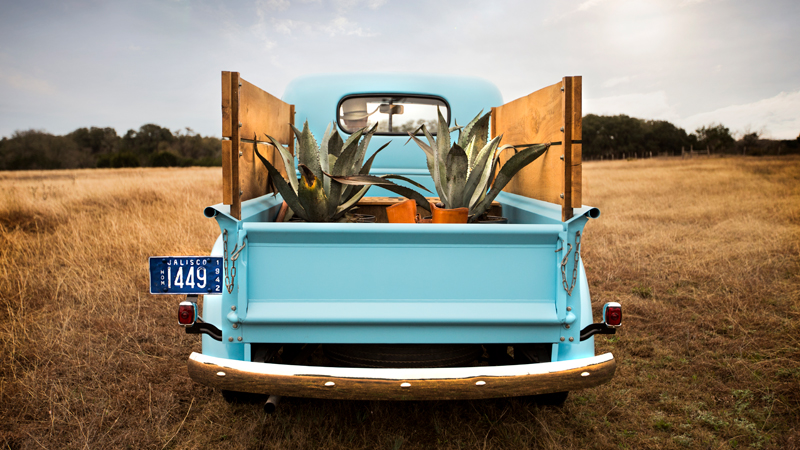
It sounds like a question from a pub quiz: What is tequila made from? Most Margarita fans know enough to shout that their favorite spirit is made with Blue Weber Agave — a large, spiky plant that grows in the rich soil of Jalisco and several surrounding states in central Mexico. But in fact, the world of Blue Weber Agave includes enough obscure information and oddball detail to supply more than a month’s worth of trivia contests.
If you want to win the next competition, here’s a guide to the drinking world’s best-loved succulent.
A Natural Beauty
Everyone knows that a great tequila is made from 100 percent Blue Weber Agave plants. But what exactly are they?
Agave is a monocotyledon, a.k.a. a monocot, the smaller of the two groups of flowering plants that also includes most grains, grasses, and canes. Somewhat surprisingly, it’s a member of the large Asparagaceae family, which makes it a (distant) relative of the same delicious asparagus that’s often served under a blanket of hollandaise sauce.
Agave’s subfamily, Agavoideae, features even more closely related botanical wonders like yucca plants, hyacinths, and the Joshua Tree. When you drill down into the pure Agave genus, there are about 270 different species of the spiky plants we know and love. Some, like the Queen Victoria agave, are grown ornamentally. Blue Weber Agave is the most prized cultivar of just one species, the blue agave or agave azul, known to science as Agave tequilana.
A note for those of us who love shortcuts: When it comes to Blue Weber Agave, the color is not optional. If you just say “Weber Agave” you’re actually referring to a different species, Agave weberi, a smaller plant in Mexico that can also be found in Texas and Florida. Also known as the wild century plant or Small Agave, Weber Agave without the word blue isn’t what lies at the heart of a great tequila.
Native to the Mexican state of Jalisco and surrounding regions, the beautiful Blue Weber Agave takes a long time to reach maturity, generally only flowering after five years or more. Left alone, the plant will then send out a very long stalk — think “shopping mall Christmas tree” — called a quiote, which will be topped with bushy clusters of yellow flowers. In nature, those flowers are pollinated by insects, hummingbirds, and the greater long-nosed bat, an endangered species that mates in only one known cave. (In case someone asks, it’s the Cueva del Diablo in Tepoztlán, Mexico.)
A Crucial Crop
While agave plants naturally grow in the fertile, sandy soils of central Mexico, the Blue Weber Agave is now an important agricultural crop. To facilitate growth, the long quiote stalk is cut on cultivated plants, which results in a beefed-up central core, called the cabeza, or head. After the quiote is cut, the plant is generally harvested within a year. Farmed in widely spaced rows, the sprawling agave fields make a striking image for visitors: acres of door-sized plants resembling giant thistles, whose thick, bluish-turquoise leaves contrast sharply against the deep red soil.

The growing global demand for tequila is balanced by the lengthy amount of time the plants require to grow. It takes around eight years — and often 12 or more years — before an agave is ready to make tequila. Some 400 to 500 million Blue Weber Agave plants are currently under cultivation in Mexico, of which roughly 50 million are harvested each year. Trimmed of its leaves into a piña, or pineapple, a single ripe agave usually weighs between 80 and 200 pounds, though many can clock in well over 300 pounds.
In Jalisco, Blue Weber Agave is mainly grown in two regions with two distinct microclimates: the Tequila Region of Origin, sometimes called Tequila Valley, and Los Altos, also known as the Highlands. The Tequila Region of Origin is located northwest of Guadalajara, close to the eponymous city of Tequila, with a moderate elevation — about 4,300 feet above sea level in the town of Amatitán, the heart of the area’s agave cultivation. That’s a distinct difference from Los Altos, where many agaves are grown at 7,000 feet, or even higher.
The two regions have very different soils and growing conditions — and, connoisseurs will tell you, result in tequilas with very different flavor profiles. The darker, volcanic soil in the Tequila Region of Origin is said to create spirits with more peppery, earthy, and “grittier” flavors. Tequilas sourced from agaves grown in Los Altos, where the time to maturity is generally longer than in Tequila Valley, are said to be more mineral, floral, and sweeter in flavor.
What’s in a Name?
While cheaper, “mixto” tequilas are allowed to include up to 49 percent other sugars, the term 100 percent agave is reserved for spirits of the highest quality, which, by law, must be made entirely from Blue Weber Agave. Regulations allow the synonyms 100 percent de agave, 100 percent puro de agave, and 100 percent puro agave, to which the word “azul” [“blue”] may be added.
While tequila and the Blue Weber Agave in it must come from Mexico, the agave’s name came from France — specifically, from Frédéric Albert Constantin Weber. A French military doctor and botanist, Weber was a member of the French expeditionary forces during the Second French Intervention in Mexico, when the country was temporarily part of the French Empire. In fact, Weber’s botanical studies during his 1864-1867 Mexican tour of duty focused on cacti, though he also scientifically described a few species of agave, including the two that bear his name today.
If that question comes up on your next pub quiz, you know who to thank.
Please Drink Responsibly. DON JULIO Tequila. 40% Alc/Vol.
This article is sponsored by Don Julio.


